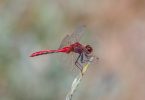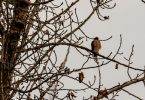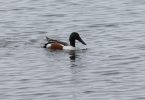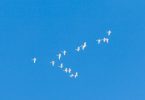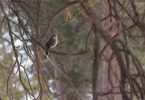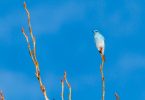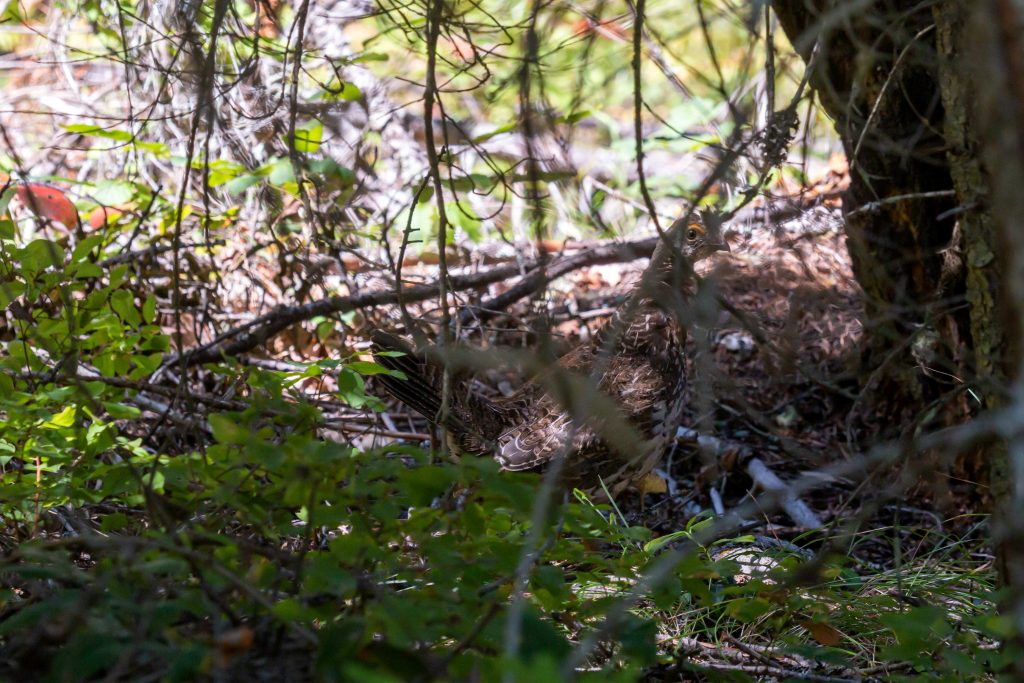
I encountered several grouse while hiking on the Big Creek trail (Bitterroot National Forest) near Victor, Montana. A couple birds immediately flew into the upper canopy of nearby mature conifers. Couple of others stopped (photo above) or slowly walked away through the shrubby/downed timber understory. I wasn’t totally prepared for this opportunity, but did swing my Canon 70 D / 180 mm macro onto the ground targets.
Have Camera for Documentation
Was fortunate that sunlight beamed onto the forest floor in spots. A spot where one of the grouse eventually ended up standing (lucky, photo below). Flip open your copy of The Sibley Guide to Birds (Sibley 2014) and the heavily shadowed bird will still be identified as Dusky Grouse (Dendragapus obscurus).

Serendipity and Luck
In August they begin to gather into flocks of 10 to 15 individuals…In September they wander above timber-line to feed on grasshoppers, reaching 12,500 feet…many remain the whole year close to timber-line.
Professor Wells W. Cooke (1897) personal communication (page 95) in Bent, A. C. (1963). Life Histories of Gallinaceous Birds. New York: Dover Publications (reprint of Bulletin 162 United States National Museum).
I did not walk the Big Creek trail to find Dusky Grouse. My target was butterflies (mostly newly hatched Comma’s) and mushrooms (recent spate of rain may have sparked some fruiting). Several Green Comma were flying, that’s it. And mushroom activity amounted to about only eight in total! So the universe provided me with a small flock of Dusky Grouse instead 😉 I have seen singleton Dusky Grouse before, but never a flock.
The luck didn’t stop there as referred to earlier, some birds did not roost high up in the trees.
Behavior, birds’ and mine
On being suddenly startled, this bird takes wing with great rapidity, sometimes uttering a loud cackling note, very much like that of the Prairie Hen on similar occasions, frequently alighting on the lower limb of a tree after flying a little way, and watching the intruder with outstretched neck.
Elliot Coues (1874) personal communication (page 94) in Bent, A. C. (1963). Life Histories of Gallinaceous Birds. New York: Dover Publications (reprint of Bulletin 162 United States National Museum).

is most difficult to locate even when perched upon a limb only a few yards away.
Edwyn Sandys (1904) personal communication (page 94) in Bent, A. C. (1963). Life Histories of Gallinaceous Birds. New York: Dover Publications (reprint of Bulletin 162 United States National Museum).
Putting this grouse encounter in perspective this is a 20 inch long bird weighing about 2.5 pounds. It is far easier to locate an eight inch long Townsend’s Warbler (Setophaga townsendi) in similar habitat. This reality is the core of my wildlife watching strategy. I visit different habitats aware of the potentials. It is always a win because there will be a bird, butterfly, wildflower, mushroom, lichen species to discover, appreciate and photograph. Just targeting a Dusky Grouse to list for a field trip goal is not a good use of my time anymore. Because really, do you find the bird or does it find you? It’s a little of both, but my “passive” process is more enjoyable, fun and holistic. Instead of a singular focus, it is now one of infinite possibility.
Evolution Began Years Ago
I have only one displaying male Dusky Grouse encounter. Only after hearing a strange series of “whoof” sounds, that I could not attribute a direction, did I see the bird after several minutes of looking. It walked a line slowly in a close-by forest opening ignoring my presence. The bird was stunning in size and appearance (photo below). I was in the right habitat at the right time of year. None of it was expected, planned. This way of wildlife watching is serving me well. Have discovered multitudes of wildflowers, butterflies etc. Something new to encounter nearly everyday. Try it 🙂


